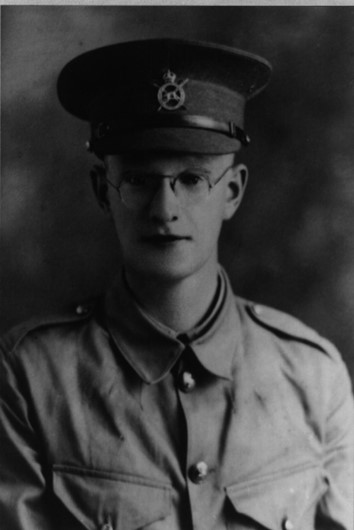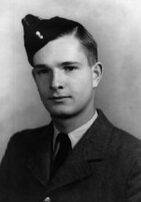Belyea Brothers Fund
The Belyea Brothers Fund was established to honour the courage and sacrifices of the three young Belyea brothers during the time of World War 2. Graham, Allan and Harry lived with their mother and father in Winnipeg, Manitoba when Canada joined the fight against Nazi Germany.

Corporal Graham Stanley Belyea
August 14, 1920 – May 1, 1941
C.M.S.C. Canadian Army
Lost at sea through enemy action.
Graham was the oldest of three sons born on August 14, 1920 to Gladys (nee Graham) and Daniel Belyea in Winnipeg, Manitoba. As a teenage boy Graham always loved sports including baseball, football and hockey during the winter at a community open air rink at Omand’s Creek. Both of his younger brothers often joined him, Allan first and later Harry. After completing grade 12, Graham started a business course but in 1938 when he tried to get a job they were very scarce unless you had extra education or technical experience. The effect of the 30’s Great Depression was still prominent in western Canada.
In those turbulent times after war broke out in September of 1939, young Canadian men had difficult choices to decide on their future. For some time Graham had been thinking about enlisting and one day late in November 1939 he came home from playing hockey at Omand’s Creek and told his Dad that some of his friends were considering joining up and he felt he should join the army. “It’s a good cause, son,” his father replied, smoking his pipe, “and its your decision to make”. So on Dec. 8th 1939 Graham joined the Canadian Army. Because of his poor eyesight without glasses he was placed in the Corps of Military Staff Clerks stationed at Fort Osborne Barracks, in Tuxedo, a suburb of Winnipeg. All of his training took place in Winnipeg.
Graham married Helen Toews on November 18, 1940 and then did many months of military training in Canada. Because of his eyesight, Graham needed strong prescription glasses and could only be placed in a noncombatant role. In the spring of 1941, Graham, now a corporal, left by train for Halifax to go overseas. Both of his brothers along with his mother and father gathered in the crowd at the Canadian Pacific Rail Station in the north end of Winnipeg to say goodbye to the small contingent of mostly administrative soldiers. He hugged his parents and shook Allan and Harry’s hands, quickly joining his buddies on the train.
Later, in Halifax, Graham’s contingent from Winnipeg joined up with other Canadian soldiers from other parts of Canada and on April 20th walked up the gangplank with all their equipment onto the ship S.S. Nerissa bound for Liverpool, England. On April 29th, 1941 the S.S. Nerissa was sunk by a German submarine. Graham did not survive.

Pilot Officer Allan Conway Belyea
February 23, 1923 – March 31, 1944
R.C.A.F. No. 103 RAF Squadron
Killed on Air Operations over Germany.
Allan was the second of three sons born February 23, 1923 to Gladys (nee Graham) and Daniel Belyea in Winnipeg, Manitoba. He was always an excellent student and got high marks in most subjects. After finishing high school he started to work as a teller at the Canadian Bank of Commerce, instead of attending university right away. The family received the sad news that the eldest son Graham was killed on April 29th, 1941 while travelling to England on a troop ship.
On February 20, 1942, 3 days before his 19th birthday, Allan enlisted in the Royal Canadian Air Force. After the initial indoctrination into the services, outfitting and aptitude testing Allan was slated to be a navigator and took his navigation training at Saskatoon from the 3rd of August to the 25th of September in 1942. His test results indicated perfect marks in signals, very high marks in mathematics, aircraft recognition and law & discipline; good marks in meteorology and passing marks in armament, navigation, airmanship, drill and anti-gas. Total average of 83.7%. He was then made a LAC (leading air craftsman) in the air navigation trade.
Allan had a steady girl friend and often spoke of Thelma and continued to see her on leaves from his RCAF training courses. His training in Canada carried on till February 1943. The Allies had a policy of utilizing crew specialties where they were most needed which meant that sometimes Canadian squadrons included British, Australian or other Commonwealth members. Allan wound up as the navigator with the Royal Air Force and 6 British crew members. On March 8th they were assigned to #103 RAF squadron at Elsham Wolds on the north east coast of England, where they continued training in Wellington, Halifax and Lancaster bombers.
On March 18, 1944, they flew their first combat mission over Frankfurt, Germany and returned safely. On March 19, 1944 the crew gathered at the parents’ home of pilot Bob Tate, where Allan’s younger brother Harry was able to visit with him for the first time in a very long time.
On the evening of March 30, 1944 they took off in a Lancaster bomber for their second combat mission. The target was Nuremberg, Germany with a total of 795 aircraft being dispatched – including Lancaster and Halifax bombers with Mosquito fighters as escorts.
In the early hours of March 31, 1944, Allan’s plane was shot down over Germany and crashed with no survivors. Later advice was received indicating that the aircraft went down just outside the village of Morles, north east of Fulda and near Schwarzbach where the crew were initially buried in the town’s churchyard until years later when the Commonwealth cemetery in Hanover was created.

Private Harry Mitchell Belyea
August 6, 1924 – December 12, 2011
HQ Squadron 28th Armoured Regiment
The British Columbia Regiment (BCRs)
Harry (the youngest of 3 brothers) was born on August 6, 1924 to Gladys (nee Graham) and Daniel Belyea in Winnipeg, Manitoba. As a youth, Harry was active in sports and excelled at mathematics. After high school, he was employed as an intern at a small accountancy firm before volunteering for the Canadian Army in 1943. He was deployed to France as a stores clerk following D-Day but was granted compassionate leave shortly before his unit (41st L.A.D.) suffered major casualties. Over the three-year period from 1941 to 1944, Harry’s eldest brother Graham was lost at sea during transport to England, his other brother Allan was lost during an air raid over Germany and his father died of a heart attack shortly after receiving the news of Allan’s death.
When the war ended, Harry studied at the University of Manitoba and became a Chartered Accountant in 1948. In the summer of 1953, Harry met Reta Robinson and immediately fell in love. Early in their courtship, Reta declined his offer of a date because she had a stack of magazines to sell. Harry bought the lot ensuring that she was free for the evening. His persistence paid off and on February 20, 1954 they were married at the United Church in Reta’s parents’ town of Brigden, Ontario. Three-year old Wayne, Reta’s son by a previous marriage, was ring-bearer. After adopting Wayne, Harry and Reta had 4 more children: Allan, Rhonda, Karen and Lisa. The family also relocated to Ottawa, Ontario where Harry worked for the Federal government. They built a home in the suburb of Nepean and every summer enjoyed family camping trips to various parts of Canada.
In 1981, Harry took early retirement. He and Reta moved full-time to their cottage property on Skootamata Lake, where they spent many enjoyable years. Harry was actively involved in the local community, serving various roles for L’Arche, a charity for people with developmental disabilities, and assisting with the launch of a local long-term care facility. In 1998, he participated in the Memory Project, talking to young people about his experiences in the war. He completed a book on this subject in 2004. He and Reta moved back to Winnipeg in 2009. Harry had a sharp mind, a sometimes silly sense of humour and a strong sense of civic duty and national pride.

